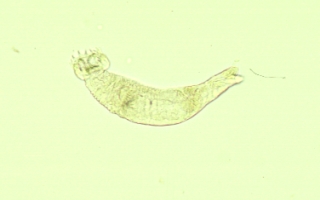



Monogenetic trematodes are parasitic flatworms that generally live of the surface (gills, skin or fins) of a fish host. Tilapia in Hawaii serve as a host for several different types of monogenetic trematodes. Several types of smaller worms (300-400 microns) occur on the skin, fins or gills, while a much larger monogene, Neobenedenia melleni, is known to attack the surface of the eye, the skin or fins of tilapia raised in high brackish to salt water. Neobenedenia melleni is a much larger worm being 2-3 mm in length and by careful observation can be seen on the surface of the eye or in roughened areas of the skin of infected fish.
All types of monogenetic trematodes found on tilapia cultured in Hawaii have pairs of hooks on one end which the worm uses to attach to the surface of the host. While alive, these worms will move either by flexing longitudinally or slowly contracting and expanding. The smaller monogenes can be easily visible under the 40 to 100X magnification with a brightfield microscope while N. melleni is visible to the naked eye.
Monogenetic trematodes have a direct life cycle which means they need only one host to complete their life cycle. In open system environments, monogenes are probably prey for one or more small predators, which help to keep the numbers of worms under control. In monoculture tanks or ponds or in screen cages, these worms can proliferate almost unchecked. At high infection levels, monogenes may cause disease in tilapia expressed by cloudy appearance to the skin or eyes, fin erosions or rot, chronic gill diseased, and, possibly anemia.
Chemical treatments such as formalin, copper sulfate, trichlorfon, potassium permanganate are often effect for the reduction of numbers of monogenetic trematodes on fish. These chemicals have not been approved for use on tilapia. Neobenedenia melleni is non-tolerant of freshwater and a freshwater dip for 5 minutes will rid tilapia of N. melleni.
Additional information on monogenetic trematodes can be found in the sections Solve a Problem/Microscopy and Treatment/Ectoparasites.




 |
 |
 |
See also:
| file: /Techref/other/pond/tilapia/monogenetic_trematodes.htm, 3KB, , updated: 2015/7/16 11:08, local time: 2025/5/12 02:16,
3.15.198.191:LOG IN
|
| ©2025 These pages are served without commercial sponsorship. (No popup ads, etc...).Bandwidth abuse increases hosting cost forcing sponsorship or shutdown. This server aggressively defends against automated copying for any reason including offline viewing, duplication, etc... Please respect this requirement and DO NOT RIP THIS SITE. Questions? <A HREF="http://sxlist.com/TECHREF/other/pond/tilapia/monogenetic_trematodes.htm"> Tilapia Topic: Disease Vectors</A> |
| Did you find what you needed? |
Welcome to sxlist.com!sales, advertizing, & kind contributors just like you! Please don't rip/copy (here's why Copies of the site on CD are available at minimal cost. |
|
Ashley Roll has put together a really nice little unit here. Leave off the MAX232 and keep these handy for the few times you need true RS232! |
.